I recently hosted a lecture series called The Viaduct. This was the first product from The Toronto Society for the Diffusion of Useful Knowledge. A new education institution building intellectual infrastructure for a skilled, knowledgeable, grounded, and loving Toronto ecosystem.
I thought that some people might be interested in the details of how this came together - I learned a lot about hosting events and what makes for a good lecture. So, I’m sharing the full story. If you have any thoughts or follow up questions please leave a comment! I’d love to chat about it.
Table of Contents
The origin story of the Viaduct
In August of last year I had an idea to host a lecture series. I’m not certain where it came from. I had been thinking about the American Lyceum and the role it used to play in education. I had been missing the drama of the theatre that I had grown up with in London, and I had an unarticulated longing for the connection between head and heart that I had experienced attending lectures at university1.
In part, it was an idea that fit the moment. I had been blessed to get a front row seat to the incredible energy that had been building in Toronto over the previous 6 months. There was excitement about community experiments like New, Hidden Rivers Tours, 535, Socratica and a huge ecosystem of smaller and larger groups, startups, and individuals. Many more than I would ever be able to list here. I wanted to help build on that energy.
In part, I just wanted to see some of my friends, and the people I admire, shine on stage. I can’t pin it down to a single cause.
Either way, I had the idea and I wasn’t able to let it go. I had a hunch it would work but I didn’t know if there would be demand for a format like this or what it would take to create the experience I dreamed of. To test the former question I asked people on X if they might be interested in an experiment like this:
This seemed promising. Hitting yes on a poll isn’t a perfect marker of whether someone is willing to pay for something, or, more importantly, if they will actually enjoy the experience. But, it was good enough to start. So, I decided to set it up. I talked to Fahd and Melody who run 535 Studio about using their space and they said yes. So, we created a Luma event and posted it online. The response was… better than expected.
I was now more than a little nervous. It wasn’t just that I wanted the idea to be a success, but I was going to be the one presenting. This was the first time I had ever given a public lecture and it felt like a lot was riding on my performance.
I hoped going into it that I had some transferrable skills from giving presentations in a corporate setting but, on the whole, it was a novel experience. At some point there is another post - or many - to be written about what I’ve learned about giving a lecture. For now though, if you’re really interested in this aspect, I would recommend you check out this video that serves as one of the best introductions to the craft:
I gave the lecture and it went better then I could have hoped for. The room was packed. The energy was high. People were smiling. At least one person laughed at one of my jokes. And, the feedback I received was overwhelmingly positive. The biggest issue we encountered was that one person got locked out of the venue by accident and missed the event (not good) but I can at least say that this was a learning about the importance of care with logistics.
I learned a lot:
The lecture format can hit even outside of an institutional setting. I definitely had - and still have - a lot to learn about why it worked and what the load bearing parts were (more on that below) but I knew that, at least some people, really vibed with it. Being exposed to new ideas and getting a chance to discuss them was something people valued.
Useful knowledge, ideas about the world that to change how you do things, can be a meeting point for many different groups across disciplines, ages and political spectrums. The lecture attracted people from 18 to 50 working in tech, education, law and more.
One of the best ways to judge if a lecture is a success is the energy of the questions afterwards. This was really driven home to me a few weeks later when I saw a lecture by Saleh Digital. When he was done the crowd mobbed him because they were so excited to just talk about the ideas. It’s the lecture equivalent of watching people belly laugh at a comedy show.
All in all the response convinced me I was on to something that could be much bigger so I started in earnest to plan for the full series.
Building community around ideas
At this point in the story a shout out to
.Misha runs Toronto’s most successful, longest-running, and most influential non-professional lecture series: Trampoline Hall. The full history of Trampoline Hall is a longer story that Misha should tell but if you live in the city (or in San Francisco) and you haven’t been to it before you are missing out. Not only is Trampoline Hall an foundational part of Toronto’s cultural make-up but Misha is a fifth standard deviation Master of Ceremonies with a completely unique set of skills. I’ve never seen anything like it.
Misha’s encouragement and advice was very helpful early on for crystallizing the learnings from this first lecture.
In particular, Misha believed that the key to this experience was community. At some level this was obvious to me but, perhaps embarrassingly, I strongly defended that there was also unique value to the lecture itself as a way to learn and a way to transform character. There’s something magic when the audience is completely locked in on the drama of the lecturer sharing not just their ideas but their way of having those ideas. Misha was…. skeptical2. He insisted that I think much harder about how to organize these events to make sure the community really came together. If this wasn’t a way for a new intellectual community like the Vienna Circle or the Bloomsbury Group to start to cohere, or if at least it wasn’t a way for many people to make new friends, then it would be worth much less than it could be. It also just wouldn’t be that fun - all the joy in life is time spent with other people3.
I knew he was right, so as I continued to work on the series I kept this thread with me - it informed a lot of the decisions I took later.
I had started scheming to figure out who would be part of the series, where it could be hosted and the like4. But I also wanted to learn more. I buy the idea from Bent Flybjerg that to do big things well the critical part is the plan and the right way to plan is not to write out some detailed description of what it is you should do. Instead, the right answer is to follow the Pixar approach: Create ever higher fidelity models of whatever it is you want to build. With each model you will learn more about what the full thing you are aimed at will look like.
So, while the full series was starting to come together I ran another experiment. A series of 3 lectures on progress5. I wanted to test: A slightly higher ticket price ($10 vs. $5), multiple lectures on back-to-back weeks, and what it would be like to present a group of related topics where it could be fun - but not required - to attend all of the lectures.
This time I partnered with Taha and Daybreak Studio. Taha had been thinking about ways to bring more events to Daybreak and after the first lecture we had started talking for a while about a collaboration like this. The studio is one of the most beautiful, cozy, well-designed spaces in all of Toronto, and the brand for Daybreak felt perfect for a collaboration given what I was starting to build. I was thrilled to get to partner on it.
Here are some of the things I learned from this second experiment:
The Q&A period is incredibly important.
The Q&A creates a series of mini-stages for people to become part of the ‘content’ of the lecture. There is a sense that they are participating in the drama of the event.
The questions people ask both broaden the field of what the lecture is about and narrow the audience’s focus on the aspects of the lecture that matter most to them. This helps to create a more interesting shared idea space (more on this later).
Managing the Q&A is an art in itself. You can’t let people’s questions turn into statements and you need to avoid certain topics but with the right initial prompting this isn’t that hard.
Misha was right: The magic of these events is in the social hour after the lecture. That doesn’t mean the lecture isn’t itself valuable but that it is brought to life in the discussion not in sitting around in seats.
Like Hofstadter's law: Food and drink matters more than you think it does even when accounting for it mattering more than you think it does. For these lectures I just bought some super basic snacks but even this seemed to really boost the mood for everyone there. Feed people!
At this point I had started working in earnest on hosting the full lecture series. Mostly this meant organizing my shower thoughts: making decisions about how long the series should be, what size of audience was appropriate, who would be good lecturers etc.
I knew that the gating factor was going to be the venue. I got lucky for the first two experiments that I had friends with beautiful spaces, who agreed to host me. For the full series though I knew I wanted to significantly increase the scale so a lot more people could attend. It was also important to have a space that was optimized for the lecture format. I didn't necessarily have a specific aim in mind though I generally thought that some kind of proscenium arch or amphitheatre would be good. I also knew that I wanted to have a space optimized for a lecture with proper seating that was angled down to the stage but that was about it.
As I was looking at different places, I came across Innis Town Hall. It was immediately obvious that this was the right answer. Innis is a 200-seat theater at the Innis College on the University of Toronto campus, less than 10 minutes walk from St. George subway station. The space is optimized for film screenings and they have an excellent AV setup. When I was talking to the team, it was also clear that they were competent, organized, and they had done this many, many times - they were a well-oiled machine.
What is a lecture?
There was one aspect of the theatre in particular, which, for me, was incredibly exciting. As I had continued to work on these lectures, I had started to form an idea about what was actually happening. This is my theory:
A lecture is a way to build a shared world of ideas.
The lecture itself foregrounds a person and their ideas for the audience. Technically, any media that presents ideas - like a YouTube video or a podcast - does this, by watching it certain things come to the front of your mind. But, what's special about a lecture is not just the dissemination of knowledge. It’s the way the audience participates in that knowledge.
The lecturer presents not just their ideas but themselves. They have rhetorical flourishes, ways of speaking, ways of moving. There is a posture to the way they hang out before the event, the way they answer questions afterwards, and the way they mingle with the audience. By putting their ideas on display in this fully embodied way - via a dramatic act - the audience gets to see what it looks like for someone to ‘have’ an idea. “The spoken word was the first technology by which man was able to let go of his environment in order to grasp it in a new way.”6 By watching an expert grasp the world in their own particular fashion the audience gains not just the ideas in the abstract but a set of tools to reshape the way they see the world.
This kind of teaching is captivating and - at least right now - we have no way to recreate it in another medium. The real magic though - and the reason it’s completely impossible to replace the lecture with YouTube, a podcast, or a ChatGPT prompt - is what happens after.
During the lecture everyone in the audience has a similar experience. They hear these ideas at the same time and in the same way. They start to inhabit a shared world. And, once the talk is done they ask questions. This elaborates that world and maps out a shared space of ideas.
Then, once Q&A finishes, we all get to hang out in this shared idea space together.
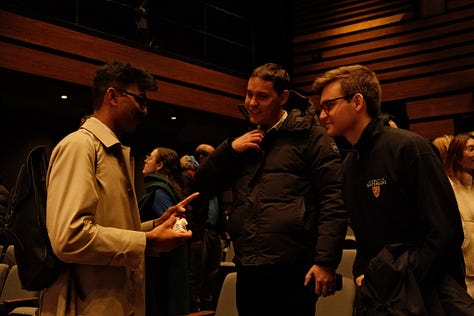
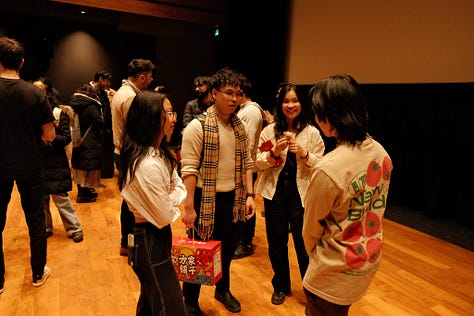
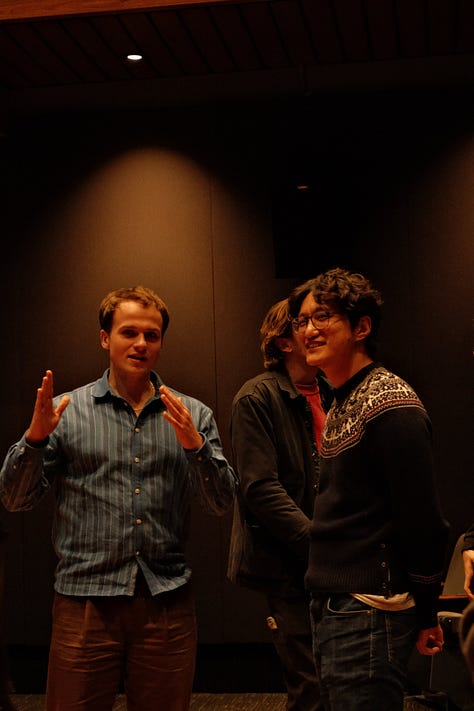
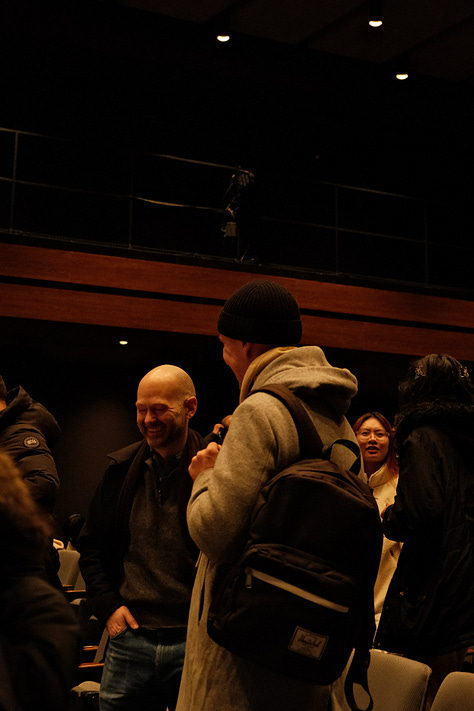
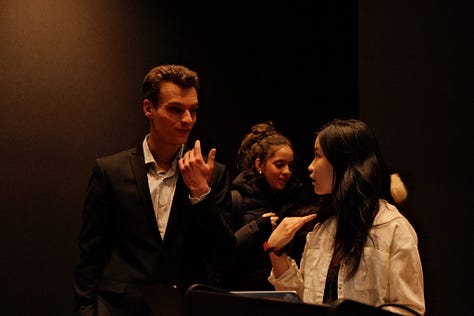

People talk to the lecturer, they talk to each other, and they start to build a community around the ideas that have been elevated to the core of that discussion. We stop being just a group of friends and acquaintances (we are that). We now have a new way to grapple with one another. Everyone comes with their own histories, their own perspectives and their own ideas but through a shared map that we are now inhabiting together we gain new tools to help each other build up those ideas and learn more about each other and the world.
Innis Town Hall is set up like an amphitheatre without a raised stage. Once the seating runs out the stage immediately starts as a flat area at the bottom of the seats. This means that after the lecture, everyone can walk down onto the stage to hang out with the lecturer. We literally inhabit the same space as the ideas.
So, I knew I was going with Innis Town Hall. I didn't know the exact date yet but I did know I wanted to move fast and get something out for winter so I could build momentum from the beginning of the year. The next element I needed was design.
Final logistics
I had put together a scrappy poster for the first tacit knowledge lecture using my own very advanced Figma skills. I had then worked with Malcolm to design the much more sophisticated poster for the series on progress.
Throughout all of 2024 I had been chatting with Mandira Midha about finding a project to work together on. I'm a huge admirer of Mandira's work. She has a unique ability to create a coherent aesthetic across multiple mediums and her style is this gorgeous combination of refined and playful. I knew that she was the person I most wanted to work with to create the vibe for this series. So we got to it and boy did she cook:


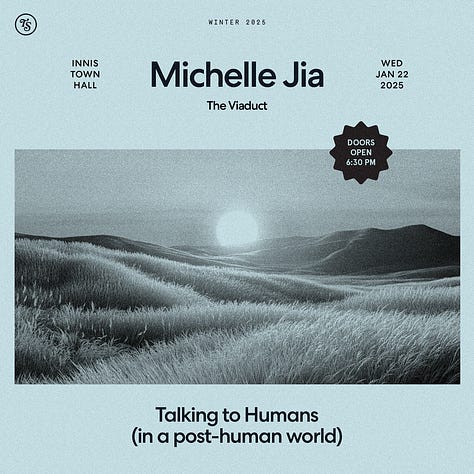


If you ever need help with creating an identity for a brand then Mandira is the person you should call. All of the tactical work with assets was great but the most amazing thing was the way she pushed forward the concept and helped to define the strategy and product. She was a wonderful thought partner.
I knew photography would be the right medium for marketing this series so I reached out to the most well connected person I know, infinite boy Tommy Trinh, who connected me with Bonnie. This was a huge stroke of luck. Bonnie is thoughtful, prudent and has an excellent eye. It became one of my favourite rituals after every lecture to look through the photos and reach out to everyone I knew to send them photos of them from the event. Toronto has a lot of beautiful people.
I also needed help with and on polling my network I got connected to Vivian Yu who acted as a host to welcome people to the event. Knowing she was able to cover tickets, set up food and drink, and answer any questions that came up saved me more stress than any single other part of this project.
At last, the slate of lecturers also came together: Eric Lombardi, Matthew Jordan, Michelle Jia, Anson Yu, and Daniel Golliher. There is a unique story to every person here and I can’t go into all the details right here but suffice to say I admire and respect all of them in their own way. This was literally my dream line up.
So, we had the lecturers, the venue, photography, logistics and art direction. The last big thing that was needed was to tell people about the event. I followed the usual approach of marketing on X and Instagram. To be honest, I don’t think I have many novel insights to share here. The one more interesting thing I did was to reach out to a bunch of Toronto media outlets. After the series started I was lucky to get featured in Toronto Today and off the back of that I also got an interview on Metro Morning. These weren’t the biggest sources of guests to the series but they definitely helped to open it up to other audiences which I was incredibly grateful for.
At this point I thought I was set and ready to go but it turned out that there was one essential thing missing. At a late thanksgiving party hosted by David Zhao I met Kiaran McMillan aka Kubla. Kiaran is an exceptional musician. I told him about what I was doing with the Viaduct and it seemed like there might be a way to collaborate on it. In the end we agreed that he would open every show. His music was ideal as he would put it at once ‘intimate and electrifying’. It created a perfect atmosphere for the event.
Then finally on January 7th, in the dead of winter, we went live and kicked off the Viaduct Winter Season 2025. It was probably the best thing I’ve ever had a role in making in my life.
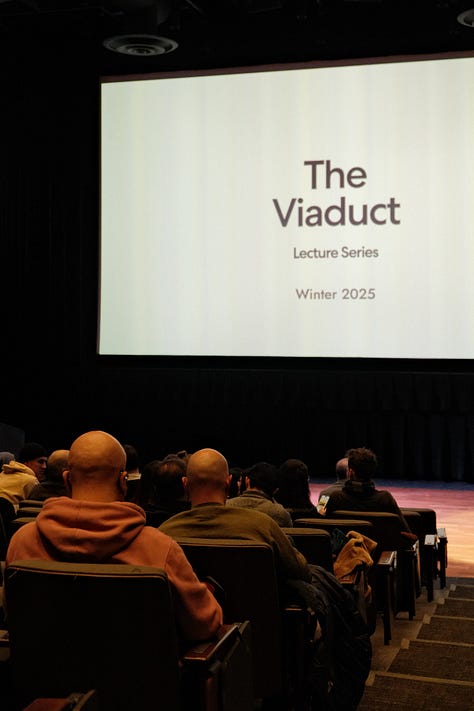
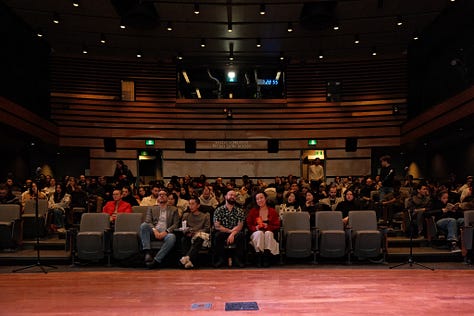
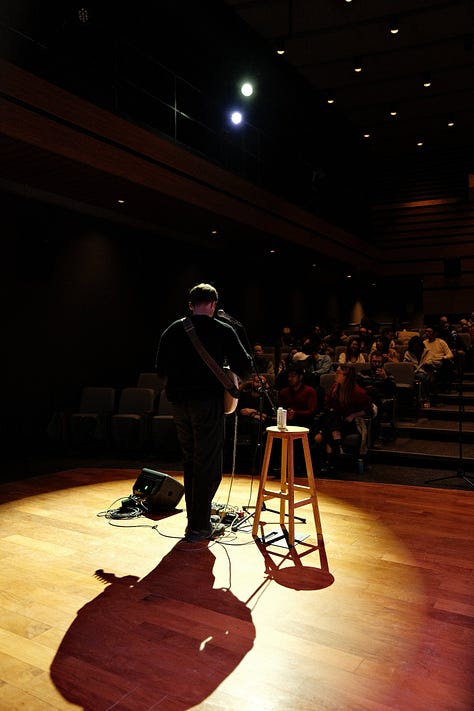

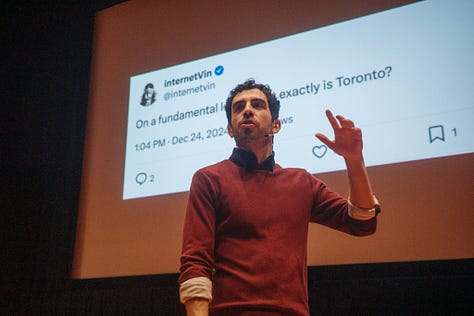


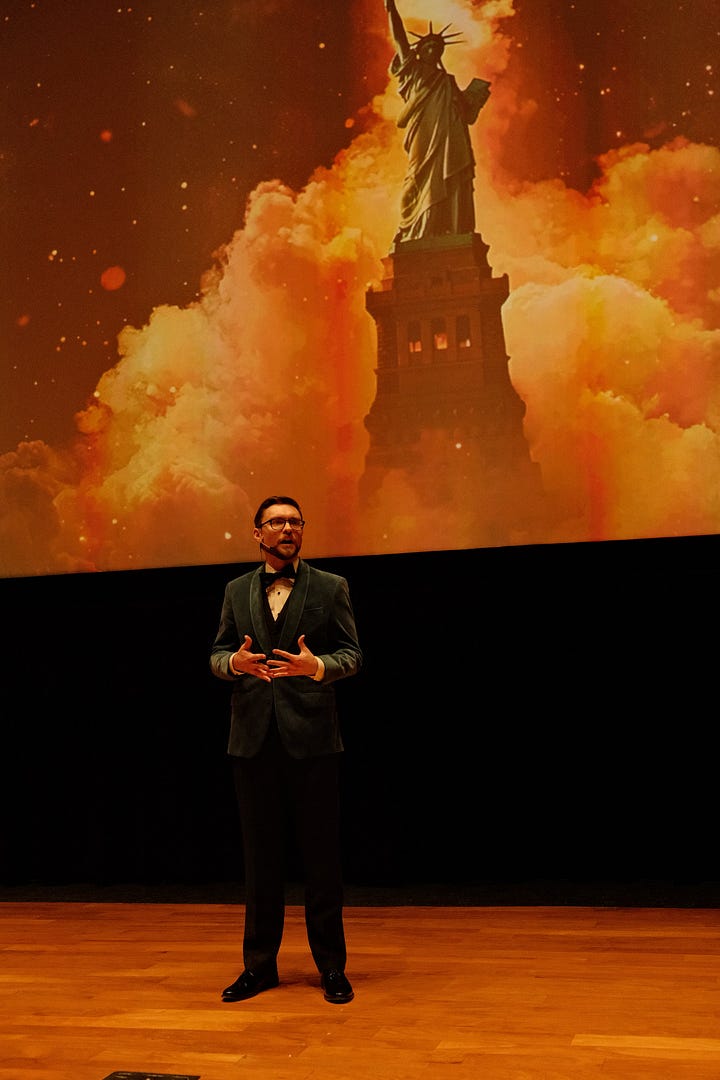
Here are some of the other things I learned:
Art direction matters. A lot. I had dozens of people come up to me to say they had seen the lecture posters on Luma and that was the main reason they had decided to come.
The ideal lecture is both instructive and inspiring. Useful knowledge is great but it must also connect to a deeper vision of what it means to be human.
You can ‘ladder’ media. Try to get placed in small media first and then use that to graduate to larger platforms.
Through a combination of my own network, word of mouth, media laddering and connecting to multiple groups like the audience for Trampoline Hall the lectures were able to effectively blend together multiple age groups and otherwise very different demographics. People loved this aspect. It was so cool to see retired people learning from students and vice-versa.
Running this series changed the trajectory of my life. I know it may not take this exact form and things will surely change a lot but I want to run a series like this and invest in the work of lectures and similar educational experiences for the rest of my life. I love the community that has started to form and Toronto’s nascent intellectual culture.
The Viaduct will be back for a second season this summer.
It may seem grandiose but moving forward with this experiment I’m continuing to think a lot about the American Lyceum. What is the future of education? In particular, what is the role of the liberal arts? The humanities? What is the role of education in shaping character? What is the role an institution like the Toronto Society for the Diffusion of Useful Knowledge can play in this?
I also have a better idea of why I’m doing this. I’m going to write about it at much greater length soon but for now I can say: I want to help create a garden for ideas and the transformation of character. This is what the Toronto Society for the Diffusion of Useful Knowledge is going to explore.
There were a huge number of people that it would have been impossible for this to be a success without. People that encouraged me, came to the lectures, believed in the idea and gave me great advice. There are more than I can list but here are just some of the incredibly special people I have been blessed to know on this journey in no particular order:
Fahd Ananta, Daniel Andru, Bonnie Chin, Michael Gibson, Misha Glouberman, Daniel Golliher, Michelle Jia, Matthew Jordan, Melody Kuo, Ellen Li, Eric Lombardi, Anna Lisa Martin, Kiaran McMillan, Mandira Midha, Jenevieve Narbay, Sherry Ning, Pablo Peniche, Dan Seljak, Chris Spoke, Danielle Strachman, Alex Tribe, Tommy Trinh, Ram Vasuthevan, internetVin, Anson Yu, Vivian Yu, and David Zhao.
Thank you. You made this experience everything that it was.
I had been blessed in university to have Justin McDaniel as a mentor. I still think about his work all the time. Unfortunately, he doesn’t have much online but check out this recording of one his lectures. Insane to me it only has ~2000 views at the time I’m posting this.
After the last lecture in the series Misha took me aside and told me he finally got what I was saying. This is one of the best validations I have ever received for one of my ideas.
As I describe later I have come around to this but I think there’s validity to both perspectives. My canonical example for this is the scene in the social network where Bill Gates is giving a lecture. Mark is locked in - we’re foreshadowing that he is learning something important about how to build a huge company. And these two pretty girls whisper to Eduardo during the talk to go grab a drink afterwards. It’s the blending of these two things that is the ideal a perfect lecture should aim for. (Pay no attention to the aftermath of the relationships in this film)
In case you are a nerd about these things: My general approach to all logistics problems is to create one massive google doc and associated spreadsheet where I drop every fact I need to know about whatever it is I’m creating including all the data on things like budget etc. If you are planning your own lecture series and want to see what that looks like for the Viaduct shoot me an email and I can share it with you.
You can get a flavor for the kind of things I talked about from this recording of the last lecture. (As an aside, I think this talk summarises most of my well developed political views today.)
Marshall McLuhan





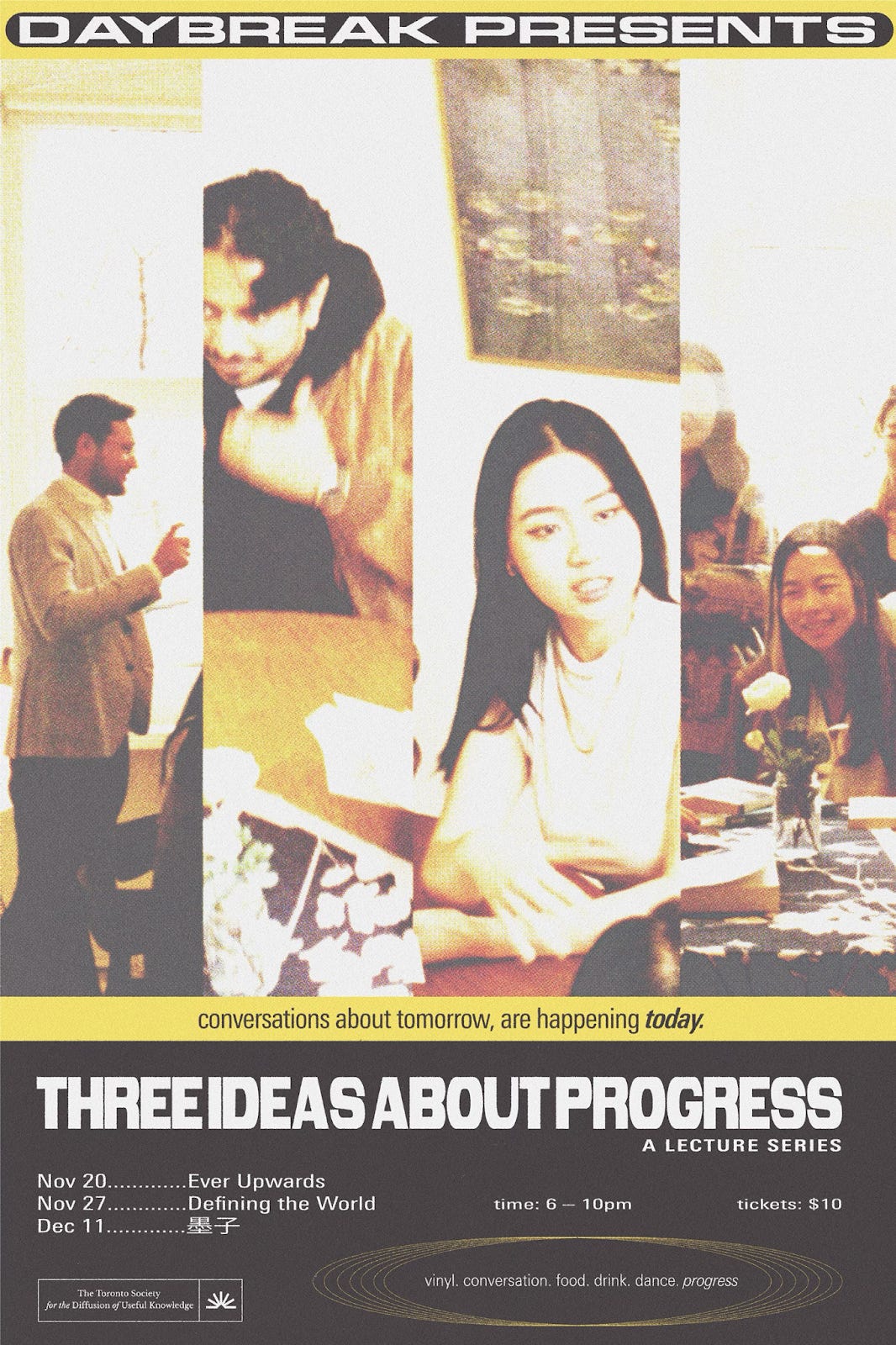


Congratulations, sir!! Your community is lucky to have your eye and your energy.
Congratulations, Ben! I'm so inspired by what you accomplished with the first season of the Viaduct. To many more!